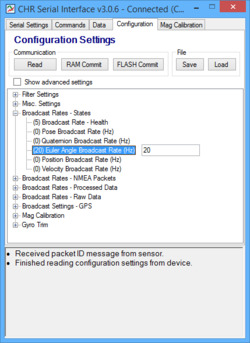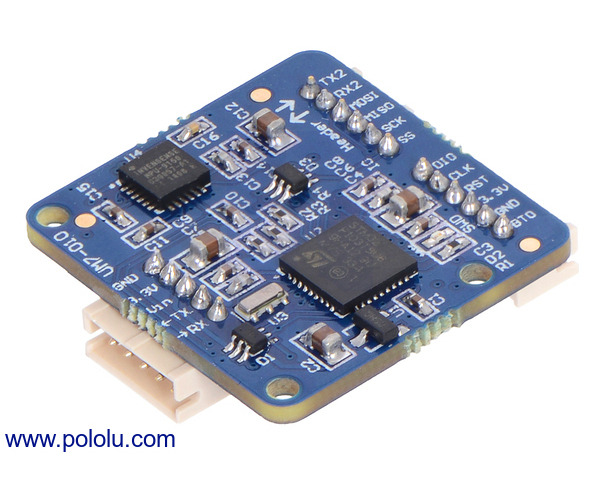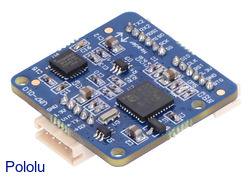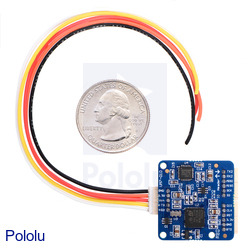UM7-LT Orientation Sensor
The UM7-LT orientation sensor from CH Robotics is an Attitude and Heading Reference System (AHRS) that contains a three-axis accelerometer, rate gyro, and magnetometer. It combines this data using an Extended Kalman Filter to produce attitude and heading estimates. This LT version of the UM7 does not have an enclosure.
Alternatives available with variations in these parameter(s): case/enclosure? Select variant…
| Description | Specs (10) | Pictures (6) | Resources (6) | FAQs (0) | On the blog (1) | Distributors (0) |
|---|
Overview
Note: A new manufacturer (Redshift Labs) has taken over making and supporting the UM7. They have released new versions of the UM7 and UM7-LT that should be functionally equivalent to the previous versions, though some of the components have been updated to replace discontinued parts and the new UM7-LT now ships with conformal coating. Due to these changes, we are selling the new UM7s under new product numbers.
The UM7 orientation sensor is a third-generation Attitude and Heading Reference System (AHRS) from CH Robotics that produces attitude and heading estimates from triaxial accelerometer, rate gyro, and magnetometer data. Unlike a typical inertial measurement unit (IMU), which only provides raw sensor readings, the UM7 features an onboard microcontroller that combines sensor data using a sophisticated Extended Kalman Filter (EKF) to generate orientation estimates 500 times a second.
Two versions of the UM7 are available: the UM7 orientation sensor, which includes an enclosure, and the UM7-LT, which does not. The two versions are functionally equivalent, and both include a cable (even though it is only shown in one of the two pictures below).
|
|
The UM7 features a number of improvements over its predecessor, the UM6, including higher gyro bias stability and lower noise, a new communication architecture for improved flexibility, optional NMEA packet transmission, UTC time-synchronization with external GPS, and support for third-order temperature compensation on all sensors. It takes advantage of newer MEMS (micro-electro-mechanical systems) technology that allows it to offer better performance at a lower price.
Connections for power and TTL serial communication can be made to the UM7 through a polarized five-pin male connector on one side, which mates with an included cable assembly. A pair of six-pin expansion headers on the other side of the board provide additional connectivity options, including an alternative SPI interface and a secondary serial interface that can be connected to an external GPS module (like our LS20031 GPS receiver). Additional cable assemblies for the expansion headers are not included.
You can use a general-purpose USB-to-TTL-serial adapter, such as our CP2104 carrier, to connect the UM7 to your computer. You can then use the CHR Serial Interface (available in the “Resources” tab) to configure the sensor, and view and log data in real-time.
Details for item #2740
Product #2740 is the LT version of the UM7, which is just the UM7 electronics without the enclosure.
|
|
As of July 18, 2014, we are shipping UM7-LT modules with the latest firmware version, U71C. Boards that shipped before this date have older firmware versions (U71A or U71B) with issues that might prevent correct operation of the SPI bus and/or cause a steady angular drift in the outputs of the UM7 in certain circumstances (due to improper EKF initialization). The firmware version can be checked with the CHR Serial Interface software. If you purchased a UM7-LT with older firmware from us and these issues are affecting you, please contact us for firmware upgrade instructions.
Product Comparison
We carry several inertial measurement and orientation sensors. The table below compares their capabilities:
| Product Name | Sensors | Estimation | Other | ||||||
|---|---|---|---|---|---|---|---|---|---|
| Gyros (3x) | Accels (3x) | Mag (3x) | Altitude | Roll | Pitch | Yaw | Quaternion | Enclosure | |
| Pololu MinIMU-9 v6 |  |
 |
 |
||||||
| Pololu AltIMU-10 v6 |  |
 |
 |
 |
|||||
| Redshift Labs UM7-LT Orientation Sensor |  |
 |
 |
 |
 |
 |
 |
||
| Redshift Labs UM7 Orientation Sensor |  |
 |
 |
 |
 |
 |
 |
 |
|
Features
Sensors and processing
- Excellent gyro bias stability over temperature
- Adjustable low-pass filter and EKF settings provide customizable performance for various applications
- States and sensor data synchronized to GPS position and velocity using optional external GPS module
- Allows for alignment calibration and third-order bias and scale factor temperature compensation for accelerometers, gyros, and magnetometer
- Magnetometer soft and hard-iron calibration can be performed through the CHR serial interface software
Communication
 |
CHR Serial Interface. |
|---|
 |
Graph of quaternions displayed by the CHR Serial Interface connected to a UM7/UM7-LT orientation sensor. |
|---|
- Output data:
- Attitude and heading (Euler angles)
- Attitude quaternion
- magnetometer, accelerometer, gyro data
- GPS altitude, position, velocity (with optional external GPS)
- 3.3 V TTL serial interface (UART) with baud rates up to 921,600 bps can stream data or provide updates on request
- Note: the main UART pins, TX, and RX, are 5V-tolerant and can be directly connected to 5 V systems that are guaranteed to read 3.3 V as high
- Transmits data using human-readable NMEA strings (up to 100 Hz broadcast), binary packets for higher efficiency (up to 255 Hz broadcast), or a combination of both
- Flexible communication architecture allows UM7 to transmit any combination of data at individually adjustable rates
- Connects to the CHR Serial Interface software to allow for real-time plotting of sensor data, logging, device configuration, and magnetometer calibration
- SPI interface available through expansion connector
Specifications
- Dimensions: 1.06″ × 1.02″ × 0.26″ (27 mm × 26 mm × 6.5 mm)
- Weight: 0.12 oz (3.5 g) without cable
- Operating voltage: 4 V to 5.5 V
- I/O logic level: 3.3 V (with 5V-tolerant main UART pins, TX and RX)
Attitude and heading
- EKF estimation rate: 500 Hz
- ±1° typical static pitch/roll accuracy
- ±3° typical dynamic pitch/roll accuracy
- ±3° typical static yaw accuracy
- ±5° typical dynamic yaw accuracy
- 0.5° angle repeatability
- 0.01° angular resolution
Videos
In this video playlist, Caleb Chamberlain from CH Robotics shows how to get started with the UM7, configure its communication settings, and calibrate its magnetometer.
People often buy this product together with:
 |
LOCOSYS LS20031 66-Channel GPS Receiver Module (MT3339 Chipset) |


















